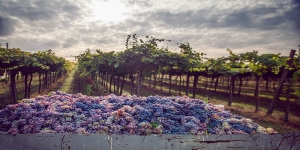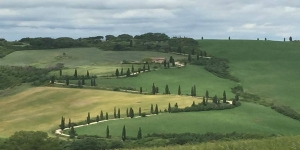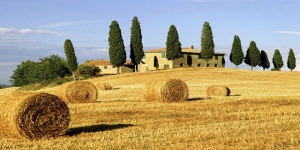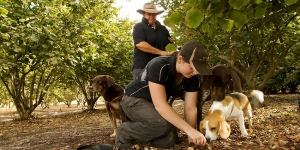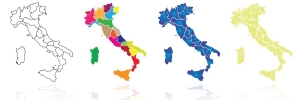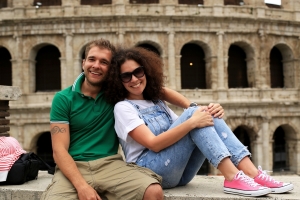Chianti Classico Wine Tour & Visit 2 Wineries – small group tour
Duration: 8 hours
Type of Service: Personal sommelier - wine expert on board, awarded but non-commercial wineries visit with the vintners and historical overview of the region
Tour Description: The Chianti Classico area is the most beautiful Tuscan wine region crossed by the scenic road SR 222 running between Florence and Siena, both great home bases if you are thinking about booking this wine tour.
The area is a patchwork of mountains, soft rolling hills covered by olive trees and slopes with perfectly cared vineyards where more than 200 Tuscan vintners are growing local grape varieties such as Sangiovese along with international grape varieties introduced in Tuscany several years ago such as Merlot, Cabernet Sauvignon, Pinot Noir.
A full day in Chianti will consist of a scenic drive and a wine tour rich in cultural insights from Etruscan times till modern times always with a deep attention to the history of winemaking in Tuscany through accurate cellar visits, generous wine tastings of Chianti Classico, Chianti Classico Riserva and Super Tuscans.
Things to Know
- Day trip from Florence to the beautiful Chianti wine region with a licensed sommelier
- Visit 2 wineries, cellar visit and tastings of wine
- Away from the crowds and big group tours, you will have access to unique wineries, off the beaten path locations, authentic Tuscan food not "snacks", professional and guided wine and olive oil tastings.
- The tour is tours a full day minivan excursion, a minimum of 3 participants is required and maximum of 8 participants
- Tour offered Monday to Sunday (Mid-March- Mid-November)
- Tour pick-up time is between 9:00am – 9:30am based on number of participants
- During winter times, tours might be limited to weekdays only - please inquire about times
- Pick-up and drop off directly at your lodging from the center city of Florence or Siena (from Siena a minimum of 3 people per booking)
- Wear comfortable clothing and walking or tennis shoes
Additional Info
- Region Tuscany
- City Florence
- Duration 8 Hours
-
Highlights
On this excursion, get an insightful way to experience Tuscany, its countryside, and Tuscany's best red wines. You will have a wine connoisseur spending a full day with you while driving you to local wineries. They will share their wine knowledge with you and infuse you with the love of wine.
-
Pricing & Booking
To book this tour, please contact This email address is being protected from spambots. You need JavaScript enabled to view it.
Highlights of the Chianti Region Tour - small group tour
Duration: 8 hours
Type of Service: Etruscan Sites, Off the beaten path hilltop town, top end winery visits with farm to table Tuscan home-made meal - Chianti Tour from Florence
Comfortable pick up from your hotel, scenic drive along the Chianti Classico area with a full explanation of the region with cultural insights.
The first stop will be at a small medieval hilltop town still a living community which keeps the village immaculate as the 9th century to get an off the beaten path experience away from the crowds and big tourists centers. The walk through the village will be escorted by your driver/guide to give you a fun, educational tour and learn about historical curiosities anyway do not expect a museum and churches tour but be ready to fill your eyes with a movie-like setting.
Next, you will visit a small Etruscan site to get a historical and archeological introduction about Tuscan's ancestors, and afterward, you will be a visit to a family run winery with cellar visit and winemaking explanation followed by a farm to table meal with wine pairing plus a tasting of extra virgin olive oil.
After lunch, enjoy a relaxing car ride back to Florence as your English-speaking tour guide/driver shares great conversations with you and answers any questions you might have about wine and the Chianti region.
Things to Know
- Day trip from Florence to the beautiful Chianti wine region
- Anna's tours are full day minivan excursions, a minimum of 3 participants is required and maximum size of 8 participants
- Tour offered Monday to Sunday (Mid-March – Mid-November)
- Tour pick-up time is between 9:00am – 9:30am based on number of participants
- During winter times, tours might be limited to weekdays only - please inquire about times
- Pick-up and drop off directly at your lodging from central city of Florence or Siena (from Siena a minimum of 3 pp per booking)
- Tour the wine cellars with an expert guide
- Savor a fresh lunch of authentic Tuscan specialties
- This is one of the best red wine production areas in the world and this tour is very flexible and relaxed
- Wear comfortable clothing and walking or tennis shoes
Additional Info
- Region Tuscany
- City Florence
- Duration 8 Hours
-
Highlights
Get an insightful way to experience Tuscany, its countryside and of course Tuscany best red wines; share your experience with other Tuscan enthusiasts
-
Pricing & Booking
To book this tour, please contact This email address is being protected from spambots. You need JavaScript enabled to view it.
Cooking Class at a Farmhouse in Tuscany - small group tour
Duration: 7 Hours
Type of Service: Cooking Class at a Farmhouse in Tuscany
A full day hands-on Cooking Class in a stunning setting in the Tuscan countryside including a food tour through the historic center of Florence. Led by a local food-lover guide, you will taste your way through the Florentine's favorite bakery and grocery stores to experience Tuscan food like a real local. You will buy ingredients on the way and in Florence's most vibrant food market.
On arrival in our beautiful farmhouse, you will start creating a complete menu, from appetizer to dessert, using only the freshest seasonal ingredients, the majority of which come from the vegetable garden of the farmhouse!
Be prepared to roll up your sleeves and learn to cook as Tuscan grandmas and moms do every day in their kitchens for their families. Master the secrets of traditional dishes that you will easily re-create at home for your friends and family. The cooking lesson is suitable for beginners and for those who can already cook.
Then finally we will all sit together outside (weather permitting) and just like a big Italian family, we will take time to enjoy the food we have prepared together. Buon Appetito!
What you can expect
First, discover Florence's historical food market where the locals do their daily shopping. Blend in with the locals. Meet the bakers, the butchers, and the farmers selling vegetables from their fields. Their stalls are full of items such as fresh fruit, vegetables, cheeses, cured meats, balsamic vinegar, sun dried tomatoes, olives and many other Italian food specialties. Shop for the ingredients to use for the cooking class and learn to choose the best seasonal products.
Then, it's time to start your cooking lesson at a farmhouse in Tuscany. This isn't just a demonstration, you will actually take part in creating a full traditional Tuscan meal with your chef's help. You will learn to make real Italian fresh pasta by hand with freshly laid eggs and learn to make a traditional meat sauce using ingredients from right outside the door!
Learn to prepare homemade pizza and classic bruschetta with fresh bread, homegrown tomatoes and the farmhouse's own extra virgin olive oil and then take a break to enjoy the pizza and bruschetta with a glass of Chianti wine.
After the break, it's back to the lesson where you will learn how to prepare traditional Tuscan roast pork, arista and Tuscan roast potatoes using fresh herbs collected from around the farmhouse. To finish the class, you will learn the secrets of the wonderful Italian coffee and cream dessert, Tiramisù.
At last, sit down to enjoy a wonderful meal. Each course will be paired with a carefully selected wine from the region to compliment the flavors of the food you have prepared. At the end of your meal, your driver will be waiting for you for a short drive back to Florence, so it's time to say arrivederci after an unforgettable experience in Tuscany.
Things to Know:
- Small-group Italian cooking class (25 people or less) at a breathtaking farmhouse set in the rolling hills of Tuscany!
- The tour/cooking class is offered Monday - Saturday based on availability and begins at 9:00 am and concludes at 5:00 pm
- Florence morning food tour with tastings at San Lorenzo's colorful Mercato Centrale
- Hands on experience: learn to make Bruschetta and Pizza, home-made Pasta, Tuscan roast pork with potatoes and Tiramisù
- Enjoy your freshly cooked meal accompanied by wine after the class
- Transportation roundtrip to and from Florence to the farmhouse
- Recipes and an Italian cooking diploma for your hard work
- Due to uneven and steep surfaces, we are unable to accept anyone with mobility issues. A minibus or van transports you to the Tuscany farmhouse. There are about 24 steps leading down towards the outdoor kitchen.
- We regret that vegetarian or other alternative dietary requirements cannot be catered for in this class
- Youth rates are available to attend with a parent/guardian for 12 yrs to 18 years of age - please inquire about youth rates
Additional Info
- Region Tuscany
- City Florence
- Duration 7 hours
-
Highlights
A full day hands-on Cooking Class in a stunning setting in the Tuscan countrysideincluding a food tour through the historic central food market of Florence. Led by a local food-lover guide, you will enjoy tastings and experience Tuscan food like a real local as well as buying the ingredients in this vibrant market.
-
Pricing & Booking
To book this tour, please contact This email address is being protected from spambots. You need JavaScript enabled to view it.
Please note: L&B Italian Tours have an on-call operator in Italy, in the event that anything changes or you have problems in Italy, you can contact us easily.
Truffle Hunting Experience with Lunch and Wine Tasting - daytour from Florence to San Gimignano
Duration: 4.5 - 5 hours
Type of Service: Truffle Hunt with Lunch and Wine Tasting - day tour from Florence to San Gimignano
Visit a unique Winery located outside the medieval town of San Gimignano, in the province of Siena. The Giachi Family has been producing wines since 1720. You will spend an amazing time as your host teaches you to taste all the wines produced at this estate and hunt for truffles with dogs who are trained to seek black and white truffles.
Located at the entrance of the Valley of Chianti, in Tuscany, about 45 minutes from Florence. This winery, is a place of relaxation and fun with food and wine. It’s the ideal place to enjoy wonderful wines and Italian specialties. A most precious delicacy of the region is the exquisite, world famous black and white Truffles. You will partake in a truffle hunt with dogs for 60 minutes and then enjoy a Tuscan lunch that includes appetizers: Tuscan salami and cheeses, Bruschetta (Bread with Olive Oil). First Course: Truffle lasagna with meat sauce. Second Course: Roasted meat with potatoes and vegetables. Dessert: Cantuccini with Dessert Wine and the tasting of over 12 wines.
Things to Know:
- You will enjoy a truly authentic "truffle hunting", accompanied by an expert truffle hunter with dogs, through the flat Tuscan woods
- In the private truffle land in Tenuta Torciano, you will find precious white and black truffles
- Learn to identify the different species of trees and the ideal habitat for the growth of truffles
- Enjoy a 4-course lunch with dessert and wine tasting
- Hotel pickup and drop-off from Florence Hotel
- Luxury Vehicle with English-speaking driver/guide
- Tour offered Tuesday, Thursday, Saturday and Sunday (March - November)
- Tour begins with hotel pickup at 9:30am
- Wear comfortable clothing and walking or tennis shoes
Additional Info
- Region Tuscany
- City Florence
- Duration 4.5 Hours
-
Highlights
Enjoy a private one-hour Truffle hunt with a professional guide that will teach you the technical information about white and black truffles, followed by an authentic lunch and wine tasting at a wine estate in San Gimignano.
-
Pricing & Booking
Price varies according to the number of people in your party. The tour includes round trip transportation from Florence with an English-speaking driver, truffle hunting with trained dogs, wine tasting fees and lunch.
To book this tour, please contact This email address is being protected from spambots. You need JavaScript enabled to view it.
Please note: L&B Italian Tours have an on-call operator in Italy, in the event that anything changes or you have problems in Italy, you can contact us easily.
Regions in Italy
So you’ve decided you are GOING TO ITALY! How Exciting! Many people dream of visiting Italy and experiencing la bella vita, and while you certainly can’t avoid it anywhere in the country, there are some things to think about before you take off that will make your time that much more enjoyable.
First, Italy is a large, and very diverse country. Traveling across regions is almost like traveling across countries themselves. The Italian people are very attached to their City, Region, and Country, in that order, so be sure to talk to locals wherever you go to get to know the intricacies of the very different regions of Italy.
Planning your trip’s itinerary won’t be easy since there is SO much to see and do, but a little background on the country’s layout is helpful when decided what it is you want to get out of your time: are you looking for sports? history? art? food? beaches? mountains? fashion? design? Italy has it all, but some places have it better than others!
Italy can best be divided into three geographical areas: north, middle and south, although again across those areas culture, food and tradition varies greatly.
Northern Italy: Alta Italia
Northern Italy is made up of the Aosta Valley, Piedmont, Liguria, Lombardy, Emilia-Romagna, Veneto, Friuli-Venezia Giulia, and Trentino Alto-Adige. It boasts such famous cities as Milan, Venice, Turin, Genoa and Bologna. The weather is cooler than the rest of the country due to the northern location and proximity to the Apennines and Alps. This area is traditionally the more wealthy part of Italy, and houses most of the country’s industry. Cities like Milan and Venice can be slightly more expensive than some cities in the central or southern parts of Italy. However, public transportation and tourism services are much more developed and functional than in other parts of the country!
The major airport for the northern region is Milan’s Linate International Airport. There are many other airports in the region however, including Bologna, Venice and Genoa, so do some price comparisons before booking your ticket. The climate in this region varies considerably, both depending on time of year and location. Venice gets extremely hot in the summer, while Turin and the Lake District (Cuomo) stay much cooler and tend to be flocked by Italians trying to beat the heat during the summer months. The Italian Alps begin their ski season as early as November in some places.
Northern Italy has many attractions and offers activities for everyone. Those who enjoy sport and the outdoors may want to visit the lakes for water sports, or go hiking in the Italian Dolomites. Everyone should see Venice at least for a day while they still can! Milan is great for anyone interested in design or fashion, and also has a wide selection of galleries and museums for those interested in both Renaissance and contemporary art. One can also visit the Italian Riviera for some great beaches.
The cuisine of this region is also quite variable, but generally tends to be no the heavier side of some of the traditional Italian specialties we normally think of. This is where Italians eat risotto with saffron, polenta, LOTS of parmigiano reggiano (from the Emilia Romagna province – an area that all foodies must visit), heavy meat dishes and stews, etc. Closer north near the Austrian border we see a lot of Austrian or Slovenian influence in the cuisine, as well as the wines. Prosecco is from the Veneto, and Gewürztraminer is from Trentino Alto-Adige. Think lots of nice white wines, and a LOT of grappa!
Central Italy: Tuscany and Rome
Central Italy is made up of the regions Lazio, Marche, Tuscany and Umbria. Geographically it also contains Abruzzo and Molise, but they are traditional grouped with Southern Italy due to cultural similiarities. This is where the rolling hills of Unbria and Tuscany call to mind Napa Valley. This is wine country. Central Italy is home to cities like Florence, Siena, Perugia, and of course Roma. Still quite wealthy, but more varied wealth across regions, central Italy is also extremely easy to explore via bus or train, so you can visit some little hill towns in the Val D’Orcia, or take a train and ride up and down the coast. This section of Italy is full of tiny medieval towns, and if you do your research ahead of time, you could get to participate in one of their on-going traditional medieval festivals!
Rome and Florence both have international airports, as does Pisa. Flying into Bologna is also an easy way to get to Florence as they are connected via both fast and regional trains. The weather in the region is quite temperate, with clearly distinct seasons similar to the weather on the mid-Atlantic coast of the U.S. The winters are cold, and although snow is uncommon it is not unheard of. The summers get quite hot, going up to one hundred degrees, and the air tends to be humid, especially inland.
Florence and Rome are the dominating destinations in Central Italy, and rightfully so. Rome as the capital and Florence as the birthplace of the Renaissance are not to be missed if possible. I would argue each city really deserves its own trip to truly get the most out of what they have to offer. Rome is a massive metropolitan center, filled with tourists all year round. The Vatican is a major destination, its museums housing some of the most beautiful and famous Renaissance artwork, as well as the Michelangelo’s Sistine Chapel. The City of Rome of course has many ancient Roman ruins that would excite anyone remotely interested in human history: the Coliseum, Roman Forum, Palatine Hill, and the Catacombs, just to name a few. Florence on the other hand is the must-visit for anyone interested in Renaissance art or history, and is also a good base to explore some of the smaller towns in the region that will have you thinking of Under the Tuscan Sun. The Chianti region is full of tiny gems to visit and have an amazing meal at, as is the area between Siena and Rome. You’ll have to get to know the regional bus lines though!
Again, each region has its own traditional cuisine, but Central Italy has some of the healthiest, heartiest, what traditionally would have been peasant food but has now been elevated to an incredible level of International renown. Bistecca alla Fiorentina can only be truly enjoyed in Tuscany, just as Rome is the place to eat Saltimbocca or Osso Buco. Siena is famous for its sweets, traditionally eaten at Christmastime, and the Umbrian town of Norcia, in the Appennine foothills is where the best black truffles can be found, as well as some of the best pork products like prosciutto and salame. The hills are home to wild boar, which is cooked into many traditional stews or sauces. This is also wine country, so look out for Chianti, Montalcino, Montepulciano, and Vernaccia di San Gimignano. I could write a whole article about Tuscan cuisine, and I probably will, so check our blog frequently!
Southern Italy: Untouched
Southern Italy is where many Italian Americans origins are. It is the poorest part of the country, and encompasses the “foot” part of the boot of Italy, as well as the island of Sicily and some other Islands off the coast of Naples. It is made up of the regions of Abruzzo, Apulia, Basilicata, Campania, Calabria, Molise and Sicily. Due to traditional poverty and well-known corruption, transportation to many less-frequented yet extremely beautiful areas is difficult without a car of your own. The trains are regional and buses connecting cities are infrequent. We’ll talk more about renting cars in Italy later, but this may be the area to do so if you are up for the challenge!
The nearest major international airport is Rome, but there are two smaller airports on the east coast: Bari and Brindisi, both in Apulia. Naples has an international airport, and the island of Sicily may be reached via Palermo in the north or Catania in the south. The climate in the South is Mediterranean, so again variable across seasons but markedly warmer than the north or center of the country. The area is frequently overlooked as a tourist destination, so it is a nice respite from the throngs of Florence or Venice if you have the chance to visit. The beaches are spectacular, overlooking truly crystalline water. On clear days you can even see Africa from certain points along the coast.
While Sorrento, the Amalfi coast and the island of Capri are all beautiful places to visit, they are also the most famous tourist destinations in this area. If you are looking for beautiful vistas and country club style and treatment, these resort towns are a perfect place to pamper yourself or take a boat out. If you are more on the adventurous side, continue south and explore the towns of Calabria, famous for its spicy peppers and warm inhabitants. From Naples you can climb Mount Vesuvius and eat a traditional Neapolitan pizza. Matera, in the Basilicata region, is slated to be the European Capitol of Culture in 2019, and boasts what are thought to be among the first ever human settlements in Italy carved out of the rocks that make up its ancient city center. Those interested in architecture will enjoy the cities along the southern coast of Sicily, where due to volcanic and seismic damage, many buildings were rebuilt in a new Sicilian Baroque style.
Southern Italian cuisine is what most Americans think of as Italian cuisine: eggplant parmigiana, pizza, calzone, spaghetti, maccheroni, and the list goes on. The region is big on short, dry pasta, as opposed to the soft egg pastas of the northern, wealthier regions. Mozzarella is from this area, as is ricotta, made light and fresh. San Marzano tomatoes are grown in the volcanic soil under mount Vesuvius, and are used ubiquitously. Many of the dishes served in the south have Italian-American counterparts due to generations of Italians emigrating to the US from these regions due to extreme poverty. This part of Italy also of course produces much of its own wine, but the wine tends to be drunk young and domestically, rather than bring preserved and shipped. So come here if you are okay with some chilled red table wine or a beer with your pizza!
This has just been an EXTREMELY brief overview of what you might expect as you plan your trip to Italy. Every part of the country has its own secrets, cuisines, and traditions, but if you can’t move there, these generalized descriptions should help you tailor where you want to start and end your visit to the big boot. Once you determine your itinerary, be sure to check seasonal weather charts so you can pack accordingly to where you will be visiting. Read on for more about the items that you will need to bring with you to get the most out of your Italian vacation!
Missy & Mark
In May of 2014, my husband and I experienced the trip of a lifetime to Italy. L&B Italian Tours arranged the entire trip and we just showed up.
It was fantastic! We experienced fabulous food, scenery straight out of a storybook, and wine. Oh, the wine!
One of the best parts of the trip was our tour guide – Silvia. She showed us Florence, Greve, the beaches at Viareggio and various vineyards in the Tuscan and Chianti regions that we would never have found on our own.
The trip was first-class in every way and we can’t wait to return!

